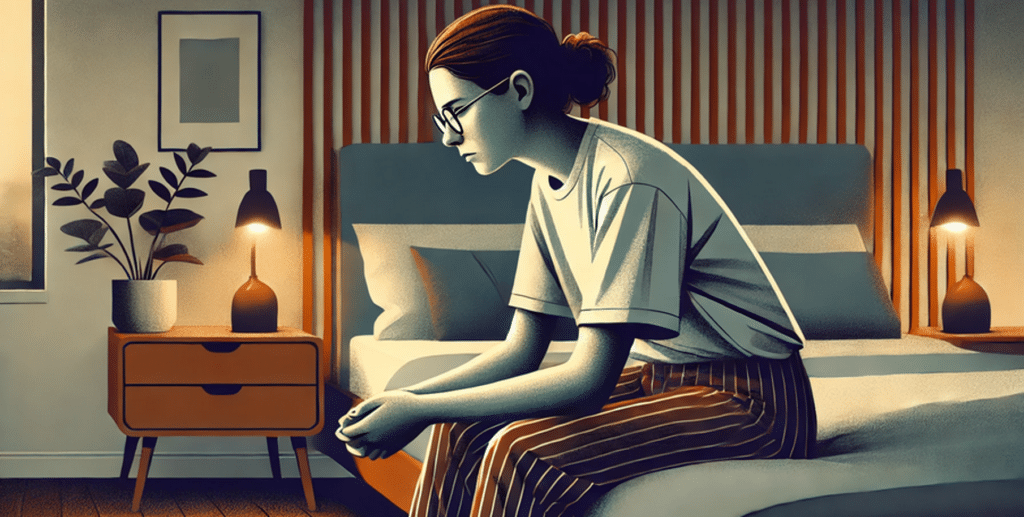Key Takeaways
- Schizoaffective disorder presents with symptoms of schizophrenia and mood disorders, creating diagnostic challenges due to the overlap of psychotic and mood symptoms.
- The disorder stems from a combination of genetic, environmental, and neurobiological factors, and there’s no one clear cause.
- It can mess with your thinking, your feelings, and your daily life. You might see things that aren’t there (hallucinations) or feel really sad or excited (mood disturbances).
- Schizoaffective disorder is divided into three types: bipolar, depressive, and mixed. Each type of disorder needs its own treatment plan.
- Paliperidone is used effectively to treat both the psychotic and mood-related symptoms of schizoaffective disorder. At AMFM, treatment plans for schizoaffective disorder are personalized, integrating medication management with therapy to address both symptom types and improve overall functioning.
What is Schizoaffective Disorder?
Schizoaffective disorder is a mental health condition that combines symptoms of schizophrenia, such as hallucinations and delusions, with mood disorder features, including depression or bipolar disorder. This condition presents significant diagnostic challenges because individuals experience both types of symptoms, making it difficult to distinguish them from related mental health disorders.
The disorder requires careful management due to its dual nature, combining the psychotic symptoms typical of schizophrenia with significant mood disturbances. As a result, schizoaffective disorder is particularly challenging to diagnose and treat, requiring a nuanced approach that addresses both the psychotic and mood components. 1
Causes of Schizoaffective Disorder
Scientists have not pinpointed a single cause for schizoaffective disorder; it’s known to arise from a complex interplay of genetic, environmental, and biological factors. Genetics plays a crucial role as the disorder tends to run in families, though not everyone with a genetic predisposition will develop it. Environmental factors also influence the onset, with elements such as prenatal stress, childhood adversity, and other significant life stressors increasing vulnerability in those genetically predisposed.
Differences in brain structure and function are evident in those with schizoaffective disorder, pointing to biological underpinnings. Variations in the size of certain brain areas and the connections between them may affect how individuals process information and emotions, contributing to the symptoms of the disorder. This intricate mix of genetic, environmental, and neurobiological factors makes diagnosing and treating schizoaffective disorder particularly challenging, requiring a nuanced understanding of its multifaceted causes. 2
| A Mission For Michael: Expert Mental Health Care Founded in 2010, A Mission For Michael (AMFM) offers specialized mental health care across Southern California, Washington, and Virginia. Our accredited facilities provide residential and outpatient programs, utilizing evidence-based therapies such as CBT, DBT, and EMDR. Our dedicated team of licensed professionals ensures every client receives the best care possible, supported by accreditations from The Joint Commission and the California Department of Health Care Services. We are committed to safety and personalized treatment plans. Start your recovery journey with AMFM today! |
Symptoms of Schizoaffective Disorder

Schizoaffective disorder significantly affects cognition, emotion, and daily functioning, characterized by a mix of psychotic and mood-related symptoms. 4
- Common Symptoms: Like schizophrenia, schizoaffective disorder manifests with several key psychotic symptoms that disrupt a person’s thinking, perception, and ability to function:
- Cognitive symptoms: Difficulties with attention, memory, and processing information.
- Delusions: Strongly held erroneous beliefs.
- Disorganized thinking and speech: Incoherent or nonsensical communication.
- Hallucinations: Seeing or hearing things that aren’t there.
- Negative symptoms: Such as a lack of motivation and reduced emotional expression.
- Mood-Related Symptoms: Unique to schizoaffective disorder, mood episodes vary widely but typically include:
- Depression: Feelings of sadness, hopelessness, and fatigue that can lead to withdrawal from social interaction.
- Mania: Periods of mood or irritability, increased energy, decreased need for sleep, and impulsive behaviors that can result in risky activities.
Types of Schizoaffective Disorder
Schizoaffective disorder is divided into types based on the mood symptoms that predominate, aiding in tailoring treatment approaches for each individual. 5
- Bipolar Type: This type involves episodes of both mania and depression along with psychotic symptoms. Treatment usually focuses on mood stabilization and management of psychotic symptoms using a combination of medications and therapies aimed at both mood and psychotic disorders.
- Depressive Type: Characterized by depressive episodes alongside psychotic symptoms, without the occurrence of manic episodes. The therapeutic focus is on alleviating the depressive symptoms while concurrently managing the psychotic aspects, often requiring antidepressants in conjunction with antipsychotics.
Paliperidone & How It is Used for Schizoaffective Disorder
Paliperidone, an antipsychotic medication, is primarily prescribed to treat schizoaffective disorder by balancing neurotransmitters in the brain, thereby stabilizing mood and reducing symptoms like hallucinations and delusions. Approved by the FDA, it is available in various formulations such as extended-release tablets and long-acting injectables, offering flexibility in dosing and improving treatment adherence. 6
This medication is often a key component of a comprehensive treatment plan that may also include therapy and lifestyle modifications. The different formulations of paliperidone – oral tablets for daily use and injectables for monthly administration – enable customized treatment plans that accommodate individual needs and lifestyles.
How Paliperidone Works

Paliperidone targets specific neurotransmitters in the brain, primarily acting on dopamine D2 and serotonin 5-HT2A receptors. As such, it helps reduce symptoms of schizoaffective disorder by reducing excessive dopamine activity, which is linked to psychotic symptoms like hallucinations and delusions. The medicine also controls serotonin levels, which can stabilize mood and improve cognitive functions.
Paliperidone targets these receptors without affecting others, like histamine H1 or muscarinic M1, so it reduces the side effects that other antipsychotics cause, like weight gain and sedation. 7
Paliperidone’s Effects on Schizoaffective Disorder
Paliperidone effectively treats schizoaffective disorder by regulating neurotransmitter pathways, alleviating psychiatric symptoms. It targets both psychotic and mood-related symptoms by moderating dopamine and serotonin levels. Regular treatment can help you have fewer psychotic episodes and mood swings, which leads to better daily functioning and fewer hospital stays.
The long-lasting forms of paliperidone make it easier for patients to take their medicine regularly, which is key to staying on track for long-term treatment success. These formulations keep your meds at the right level, prevent symptoms from coming back, and make it easier to stick to the regimen by cutting down on how often you have to take your meds. This helps keep your symptoms under control, which is key for managing this disorder over the long term. 8
How Long Paliperidone Takes to Work
Paliperidone typically starts to alleviate symptoms within the first 1-2 weeks, particularly hallucinations, disorganized thinking, and delusions. While some symptoms may not completely resolve, improvements in motivation and social engagement often begin within the first couple of weeks. Full benefits, however, may take 2-3 months to manifest. Continual use leads to better symptom management over time. 9
Paliperidone Doses
The initial recommended dosage of paliperidone is 6 milligrams (mg) once daily, taken each morning. Depending on individual response and tolerance, some patients may require a lower dose of 3 mg per day. The dosage can be adjusted as needed but typically does not exceed 12 mg per day. 10
Possible Side Effects of Paliperidone
Paliperidone is generally well-tolerated, but like all medications, it can cause side effects, which include difficulty with speaking, drooling, and muscle stiffness. Patients might also experience a fast or irregular heartbeat, increased body movements, and uncontrolled facial movements.
Less commonly, individuals may report more serious effects such as chest pain, confusion, cough, and difficulty swallowing. There might be changes in blood pressure, unusual facial expressions, or motor difficulties like a shuffling walk or tremors. 11
Take the Next Step Toward Better Mental Health

At A Mission for Michael, we recognize the complexities of living with conditions like schizoaffective disorder. That’s why we provide continuous, personalized care within a nurturing, home-like setting. We integrate evidence-based therapies such as Cognitive Behavioral Therapy and Dialectical Behavior Therapy, along with experiential treatments, to ensure long-term recovery and significant improvements in quality of life.
If you or someone you know is grappling with severe mental health challenges and needs comprehensive support, our team is ready to assist. Contact us today to learn how our tailored approach can facilitate healing.
Learn more about treatment options like Lurasidone (Latuda) here.
Start your recovery journey with AMFM today.
Frequently Asked Questions (FAQ)
What is schizoaffective disorder?
Schizoaffective disorder is a mental health condition that combines symptoms of schizophrenia, like hallucinations and delusions, with mood disorder symptoms, like depression or bipolar disorder. This makes diagnosis and treatment particularly challenging.
What causes schizoaffective disorder?
The disorder is thought to arise from a combination of genetic, environmental, and biological factors. There is no single cause, but a mix of genetic predisposition and life stressors can increase the risk, alongside observable differences in brain structure and function.
What are the symptoms of schizoaffective disorder?
Symptoms include a blend of psychotic features such as delusions and hallucinations, and mood-related symptoms ranging from depressive episodes of sadness and fatigue to manic episodes of heightened mood and energy.
How is schizoaffective disorder classified?
It is categorized into bipolar type, which includes episodes of mania and depression, depressive type, characterized solely by depressive episodes, and mixed type, which features a combination of manic and depressive symptoms.
How does Paliperidone treat schizoaffective disorder?
Paliperidone, marketed as a medication under various formulations including oral and injectable options, targets neurotransmitters like dopamine and serotonin to manage and alleviate both psychotic and mood-related symptoms of schizoaffective disorder.
Resources
- https://www.yalemedicine.org/conditions/schizoaffective-disorder
- https://medlineplus.gov/genetics/condition/schizoaffective-disorder/#causes
- https://www.mayoclinic.org/diseases-conditions/schizoaffective-disorder/symptoms-causes/syc-20354504
- https://www.mayoclinic.org/diseases-conditions/schizoaffective-disorder/symptoms-causes/syc-20354504
- https://www.mayoclinic.org/diseases-conditions/schizoaffective-disorder/symptoms-causes/syc-20354504
- https://www.drugs.com/history/invega.html
- https://www.psychdb.com/meds/antipsychotics/second-gen-atypical/2-paliperidone
- https://www.mdpi.com/2035-8377/13/3/35
- https://www.nami.org/about-mental-illness/treatments/mental-health-medications/types-of-medication/paliperidone-invega/
- https://www.mayoclinic.org/drugs-supplements/paliperidone-oral-route/description/drg-20070811
- https://www.mayoclinic.org/drugs-supplements/paliperidone-oral-route/description/drg-20070811












